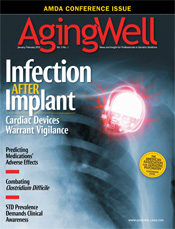
January/February 2012
Are Hip Fracture Rates Rising
or Falling?
By Diane L. Schneider, MD, MSc
Aging Well
Vol. 5 No. 1 P. 34
Hip fractures are killers.
Tens of thousands of elders die each year and many more are debilitated after fracturing a hip. Not only are there major implications for an individual’s independence but also for his or her family, along with major expenditures for the provision of health and social care. An admission due to a recent hip fracture is an all-too-familiar scenario in the long term care setting.
Unfortunately, the treatment of osteoporosis and the reduction of fracture risk remain off many clinicians’ radar even after a patient has experienced a fracture.
Nonetheless, the rates of hip fractures in Western countries appear to be decreasing. According to Medicare data, the rate of hip fracture in older women declined 24.5% from 1995 to 2005.1
At the American Society for Bone and Mineral Research’s annual meeting in 2011, the Study of Osteoporotic Fractures Research Group presented information on similar falling rates for all fractures, not just hip fractures, in women aged 80 and older from 1992 to 1997 and 2002 to 2007.
But Joan McGowan, PhD, director of the Musculoskeletal Diseases Branch at the National Institute of Arthritis and Musculoskeletal and Skin Diseases (NIAMS), said, “We can not declare victory.” She went on to say that providers need to do much more. These data show that awareness, education, and treatment are working, but providers cannot stop their efforts and become complacent.
About one-half of the patients who present with a hip fracture have a history of a previous fracture. Age plus a prior fracture are the two best predictors for an osteoporotic fracture. As geriatricians, we need to continue to focus on this silent, serious, and common disease by targeting those with prior fractures to reduce the risk of another.
Optimize your patients’ bone health. Even though a debate is raging over what should be the daily supplemental amount of vitamin D and target vitamin D blood level, the simple measures of adding vitamin D and calcium via diet or supplements reduces falls and fractures in high-risk elders, as demonstrated in randomized clinical trials. Fall prevention is paramount to reducing injuries. In addition, decrease patients’ exposure to medicines that may accelerate bone loss and control other chronic diseases that may contribute to poor bone health.
Prescription osteoporosis medicines may be helpful for decreasing fracture risk but need to be part of an overall treatment plan. One agent, zoledronic acid (Reclast), decreased mortality rates even after hip fracture in the HORIZON (Health Outcomes and Reduced Incidence With Zoledronic Acid Once Yearly) Recurrent Fracture Trial.
While the age-specific rates of hip fractures have been declining in most countries in the West, rates appear to be increasing in areas of Asia that are undergoing urbanization. For example, in Beijing, China, most residents have moved into apartments furnished with Western-style chairs, couches, and toilets. Sitting instead of their traditional squatting, along with reliance on cars and buses rather than walking or biking, are being blamed for this rise in hip fractures.
It’s food for thought. Although I doubt we will adopt squatting in the United States, it’s never to late to work on quadriceps strength and balance.
— Diane L. Schneider, MD, MSc, a geriatrician and epidemiologist, is a former associate professor of medicine, the author of The Complete Book of Bone Health, and cofounder of 4BoneHealth.
Reference
1. Brauer CA, Coca-Perraillon M, Cutler DM, Rosen AB. Incidence and mortality of hip fractures in the United States. JAMA. 2009;302(14):1573-1579. |

